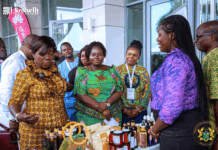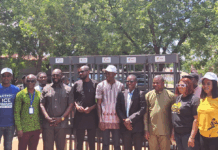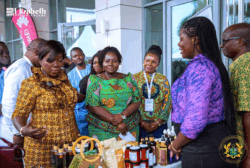Agriculture remains the mainstay of many economies in the world. This view is further strengthened with onset of the COVID-19 pandemic. However, a major challenge is limited access to the use of mechanisation in the production process.
Rudimentary tools such as the hoe and cutlass are still used as the main tools for land-clearing, ploughing and sowing. The hoe has been used in land preparation for millennia. It makes one wonder when the hoe be in museums and give way for full-scale mechanisation of agriculture.
The situation of agriculture mechanisation in Ghana
The vision for Ghana’s agriculture is to have a modernised agriculture culminating in a structurally transformed economy and evident in food security, employment opportunities and reduced poverty. Therefore, one cannot talk of modernised agriculture without the use of modern implements for land preparation, clearing, ploughing among others. Agriculture mechanisation is far from being a reality in Ghana.
The country’s tractor to farmer ratio stood at 1:1,500 as at 2016, according to a working paper entitled‘Mapping current incentives and investment in Ghana’s agriculture: Lessons for private climate finance’ by the Overseas Development Institute (ODI).
The African Union, in the later part of 2019, launched a programme in Burkina Faso to symbolically banish the hoe to a museum and usher in an era of mechanisation. Ghana’s Ministry of women and Children affairs represented the president of Ghana to show Ghana’s commitment to such.
Over the years, though attempts have been made by Ghana’s Ministry of Food and Agriculture (MOFA) to establish Agriculture Mechanisation Services Entreprise Centres (AMSECs), it has not adequately addressed the problem. Most of these AMSECs have collapsed and others are too small to serve the demand.
Many farmers, especially female smallholder farmers, are unable to access mechanisation services for their farms from land preparation to harvest. Those that do are not able to get them at the appropriate time. Consequently, the majority of smallholder farmers in the food crop sub-sector are still reliant on using hoes and cutlasses for land preparation purposes.
Aside from the limited number of implements available, the appropriateness of this equipment is in question. The implements provided are not location-specific. For example, whereas some places in northern Ghana may require small hand-held equipment, big and heavy tractors are in use and thereby destroying the soil in the process. Power tillers and other hand-held equipment could be deployed to provide the services in place of these heavyweights.
Poor ploughing by untrained services providers is yet another challenge. Some operators of tractors and other mechanisation equipment have little or no training, and hence are not able to operate them properly. They end up destroying the farms – as well as the equipment that they use.
In instances where such mechanisation services are available, the price is high – hence making them inaccessible. Poor smallholder farmers are most affected, as they are not able to access these vital services to improve their farm work. This further weakens their productive capacities.
Many farmers also do not get these services on time. The Northern parts of Ghana have a short raining season period spanning June-October. Therefore, the window for farming is very limited. They require most services in a timely manner, but most often they are not able to get these services in time.
Effect of low mechanisation
The current situation of low mechanisation poses serious challenges to overall development of the Agriculture sector, especially the crops sub-sector. It has caused the vision of modernised agriculture to remain just a vision. The sector’s contribution to GDP of the country will continue to decline if nothing is done to mechanise the sector.
A major effect of inadequate mechanisation services is the increased drudgery in farming. The amount of physical strength required for farming comes with all kinds of negative effects on farmers. Some of these negative effects can lead to health implications like body pains, aches and even death.
Another is the sector’s unattractiveness to the youth. This should be a cause for concern, as there is an increasing aged-farmer population in Ghana. This does not augur well for the future of farming. This is happening at a time many youths complain they have no work to do, as they do not find farming attractive enough for them.
High production cost is yet another challenge of low mechnisation. The cost of hiring manual labour is high compared to the use of mechanisation services. The cost of production could be reduced if farmers had access to mechanisation services.
Low production is yet another challenge with respect to the inadequacy of mechanisation services. Farmers’ capacity to produce more is reduced, as most of them lack basic equipment to ramp up their production. This comes with other negative consequences, such as low incomes, food insecurity, high food prices among others.
Recommendations and way forward
The first step toward improving mechanisation is strengthening farmer groups. By this, farmer groups can be strengthened and empowered to acquire farm implements. In a group form, it will be easier for them to acquire implements such as tractors, reapers, power-tillers, threshers and milling machines among others, and a better scheme put in place for recovery.
Another is quality data for mechanisation purposes. It’s important to know the type of soil, depth of the topsoil, the acreage, the farm size, the type of crop, the locations among others for targetting. This is important for any policy decisions in the purchase and allocation of tractors.
Assembly of tractors in the medium- to long-term could be a more sustainable way of addressing the shortfall in the country’s mechanisation service delivery. Assembly plants can be located at vantage points across the country for the purpose of meeting local demand.
Refresher and ongoing trainings can be organised for operators on a yearly basis to make them more skilled in operating these implements. This will reduce the incidence of machine breakdown among others.
Finally, strong private sector participation is required. Government alone cannot do it. But with the right policy environment, it can ensure that farmers are well serviced. Private sector operators like Trotro Tractor (TT) Ltd. can be engaged by government to scale-up their service to underserved communities. A strong public/private partnership would go a long way to ensure that no one is left behind in the process.
Conclusion
In conclusion, the hoe has long been used for farming purposes over millennia – but given the need for farming to move from subsistence to business, there is need for strong and purposeful mechanisation. The COVID-19 pandemic has shown the need for the country to work toward achieving food sufficiency, and the hoe certainly is not the tool to lead in this process. Its place is a museum, and it should give way to the modernisation of Agriculture through mechanisation.
>>>The writer is a Policy Advocate and Consultant in Agriculture and Trade Services 0249731699/0209029868, [email protected]










